#Osteopilus septentrionalis
Explore tagged Tumblr posts
Text


Cuban tree frog (Osteopilus septentrionalis) By: Constance P. Warner From: Living Amphibians of the World 1966
#cuban tree frog#tree frog#frog#amphibian#1966#1960s#Jack Dermid#Living Amphibians of the World (1966)
95 notes
·
View notes
Note
From Central Florida, a lil tree frog? Very handsome
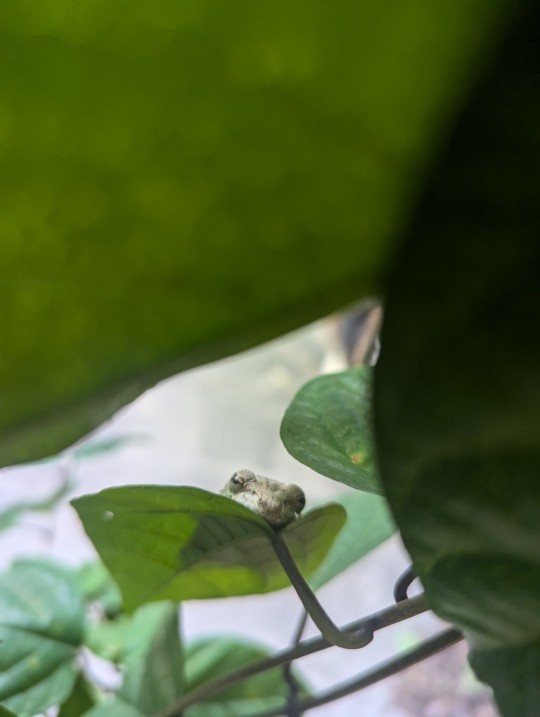

Frog ID - FL, USA:
Hello, yes, this little friend is a Cuban Tree Frog (Osteopilus septentrionalis), family Hylidae.
As the name suggests, this frog was introduced into the US from Cuba, where it is native. It is considered to be a highly invasive species.
Cuban Treefrog (Osteopilus septentrionalis) ERSS (fws.gov)
The Cuban Treefrog in Florida (ufl.edu)
114 notes
·
View notes
Text
inspired by @starfoozle's poll - happy national invasive species week! visual supplement below (and some help narrowing down the list) provided by @obeetlebeetle

#polls#invasive species#everglades#i said i'd do it and i did!!!!!#capital stuff#honorable mention to australian pine + nile monitor lizard + black and white tegu. all cool guys but not cool enough to make top 9
563 notes
·
View notes
Text
🎐 mon, jan 27
sleep :: ~8h of sleep, charged my watch
body :: 4.8k steps / 44 oz of water / all vitamins
meditation :: none
focus :: none today
reading :: like 1h 30 total? Finishing up The Only Good Indians
reflection :: i disected a Osteopilus septentrionalis and a Chamaeleo calyptratus today for class!!! it was so much fun, winding down after that with light studying and random busy work for my TA section i think will help me get to bed. i'd like to get up earlier and be more energized. my main methods are making my night routine start an hour earlier, bringing daily tea back, and getting more activity in.
2 notes
·
View notes
Text
It's a received wisdom that amphibians are intolerant of salinity in their water. With the usual caveat that Rana (or Fejervarya) cancrivora, a superficially ordinary Rana-like frog from Asia, is 'the only marine amphibian' and is presented as almost a miracle of nature. In fact, prehistoric amphibians were preserved in saltwater environments, and a few species of salamanders and frogs are tolerant of mildly brackish conditions.
One study investigated the salinity tolerances of tadpoles, belonging to a few species of North American frogs. All of the species investigated had near-perfect rates of survival at 5 parts per thousand of salinity. Where estuaries are of such a low salinity, it is clearly the freshwater components of estuarine biota that predominate. Nonetheless the salinity is elevated sufficiently at only 5 ppt, to qualify such water as brackish. The tadpoles of all the species suffered and died at higher percentages of salinity.
Thus it can only be remarkable when amphibians survive, and thrive, at higher salinities than 5 ppt. A large meta-analysis of amphibian salt tolerance, revealed that the majority of amphibian occurrences in brackish environments, predictably involved low salinities of about 5 ppt or below. Of the others, most involve salinities up to about 10 ppt. For contrast, seawater has a salinity of 33-38 ppt, and is usually communicated as 35 ppt, as though it were the same everywhere.
A salinity of 10 ppt is still at the low end of brackish salinities, below a specific gravity reading of 1.01. Therefore it is below the salinity expected to be maintained I a standard mangrove tank. A salinity of merely 5 ppt, is below 1.004. The mangrove associated R. cancrivora, is however able to complete it's life cycle, where the specific gravity would be 1.02.
It is also more significant when aquatic life stages are tolerant of saltwater, because amphibious, terrestrially motile animals may move to find freshwater. A number of species of amphibian adults, such as toads and mole salamanders, have been recorded in the field, in and around waters more saline than their proven or probable physiological tolerance.
Rana cancrivora are observed in the field to be at least temporarily present in waters with full marine salinity. Tadpoles of this species tolerate this, but the adults seem to have an upper limit of tolerance that is lower than their tadpole stages, at 28 ppt. Other amphibians with a fairly good physiological tolerance of salinity, seem limited to water where it is no more brackish, than 10 ppt or close readings.
These include the American bullfrog (Rana catesbiana), green treefrog (Hyla cinerea), Cuban treefrog (Osteopilus septentrionalis), yellow-bellied toads (Bombina variegata), common platanna (Xenopus laevis), and tiger salamander (Ambystoma tigrinum). Few amphibians tolerate higher than 10 ppt.
Adult cane toads (Rhinella marinus) live around waters with a salinity close to 15 ppt, although its life cycle is known to be impaired at salinities as low as 8 ppt, and 12 ppt is lethal to their tadpoles. Thus R. marinus, although they forage in coastal areas where the salinity is higher, are really among those amphibians bound to lower salinities of around 5 ppt or lower.
Which is to say, the aquatic life stages of an amphibian with amphibious or terrestrial adults, may be essentially a freshwater element that is present in certain estuarine environments. Some snakes and turtles similarly frequent mangroves and saltmarsh habitats, but require environmental freshwater, for example, moving to freshwater in order to drink, but feeding in brackish water.
This is the hybridity of the estuarine biota, with its marine and freshwater components, and also the bivalence of most amphibian life cycles, being able to breed in one environment, even microenvironment, whilst exploiting elsewhere. Typical amphibian life cycles are not inferior to those of reptiles and mammals, or the amphibians would not be so ubiquitous.
Which does in fact raise the question, of why there aren't any truly marine frog species. R. cancrivora and at least two other ranids, demonstrate that amphibians can actually evolve physiological tolerance to elevated natural salinities. Although this seems more common in some clades than in others. Asking the question is like asking why certain successful fish clades have remained essentially freshwater animals, such as cyprinids, loaches, tetras, and for the most part, catfishes.
Surely more than one factor is responsible, and possible explanations won't be mutually exclusive, when it comes to explaining why or why not. But competitive exclusion by clades that are established and dominant in saltwater environments, is a limit upon the range of niches, that are available for colonization, by intrusive pioneers moving down from upriver.
Adult frogs do not do very well in fast flowing waters, so they are unlikely to do very well where the tide is powerful. Some anurans have specialized tadpoles, bearing derived lifestyles and morphologies, that are appropriate to habitats such as fast flowing streams. But in such environments, fish competitors are relatively few. In the sea, frog tadpoles without mobile, paired hydrofoils, would need to compete against fishes with them, and other successful competitors.
3 notes
·
View notes
Text
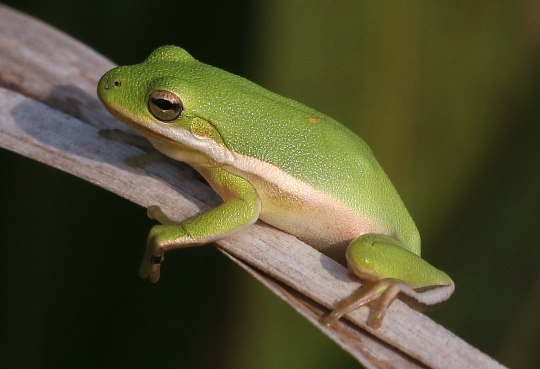
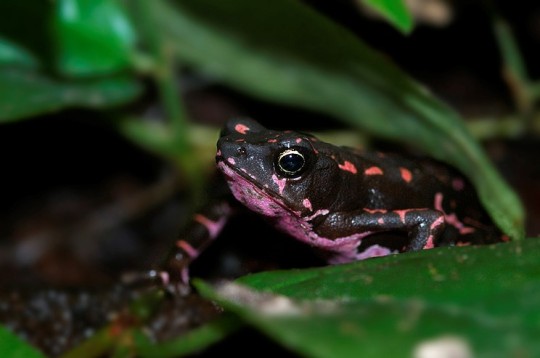
American Green Tree Frog: Naturally found in the Southeastern United States, they prefer swamps and densely foliaged lakesides as habitats. Certain coastal populations, however, have developed a tolerance to moderate salinity in water thanks to different processes that regulate osmosis. Males form large choruses during mating season, and as a result are forced to modify their calls in frequency and duration to stand out from the others and draw attention from females. In some areas, they even compete with other species such as the invasive Osteopilus septentrionalis and modify their call to be more clearly heard. Females prefer lower-frequency calls, so if a male notices that his is distinctly higher-frequency than others in the area, he may forego calling altogether and attempt to ambush a female instead.
Purple Harlequin Toad: Native to French Guiana, it was found to likely belong to the Guiana Shield clade of harlequin toads through genetic testing done in 2020. Different populations separated by location vary significantly in size, with females from the Sophie region being smaller than males – contrary to all other populations of this species. Unfortunately, they are threatened by local logging and the chytrid fungus.
3 notes
·
View notes
Text

Cuban Tree Frog
Osteopilus septentrionalis
Tampa, Florida
#reptile#reptiles#reptile photography#herpetology#herpetofauna#reptiles of tumblr#wildlife photography#wildlife#nature#naturephotooftheday#nature photo art#frogcore#frog#tumblr frogs#frogblr#cute frogs#cute#cute animals
6 notes
·
View notes
Photo

Cuban Treefrog (Osteopilus septentrionalis)
23 notes
·
View notes
Video
Cuban Treefrog (Osteopilus septentrionalis) by Allan Hopkins Via Flickr: This frog had taken up residence in my bathroom toilet bowl. I managed to catch and release it, only to find it back at home next day! Cabo San Antonio, Guanahacabibes National Park, Pinar del Rio, Cuba.
#guanahacabibes national park#pinar del rio#cuba#cu#cabo san antonio#allan hopkins#hoppy1951#cuban treefrog#osteopilus septentrionalis#taxonomy:kingdom=animalia#animalia#taxonomy:phylum=chordata#chordata#taxonomy:subphylum=vertebrata#vertebrata#taxonomy:class=amphibia#amphibia#taxonomy:order=anura#anura#taxonomy:family=hylidae#hylidae#taxonomy:genus=osteopilus#osteopilus#taxonomy:species=septentrionalis#taxonomy:binomial=osteopilus septentrionalis#taxonomy:common=cuban treefrog
28 notes
·
View notes
Text
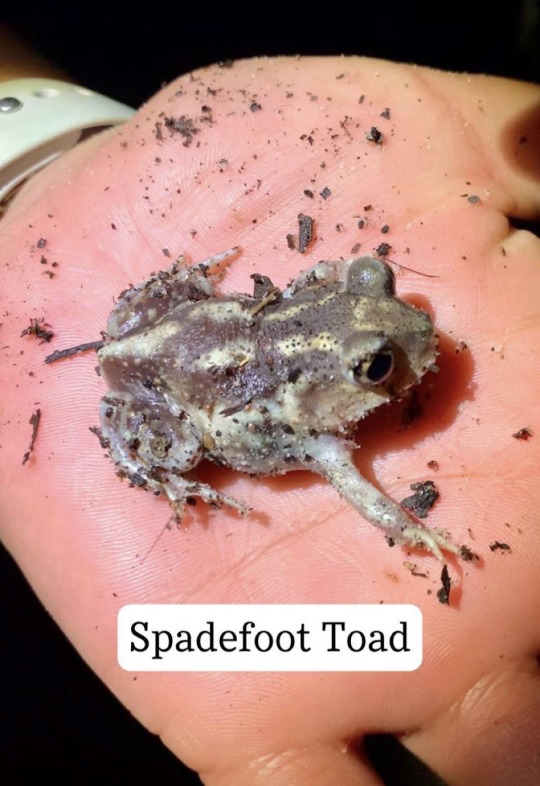
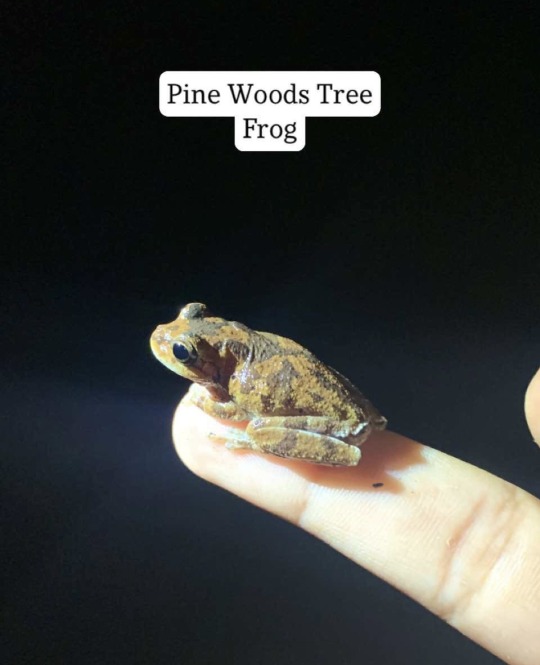


Spadefoot toad (Scaphiopus holbrookii) Pine woods tree frog (Hyla femoralis) Gray tree frog (Hyla versicolor) Narrow-mouthed (Gastrophryne carolinensis) Southern toad (Anaxyrus terrestris)
✨✨✨✨✨✨Correction✨✨✨✨✨✨ Frog that is labelled Green tree frog is actually a Cuban tree frog (Osteopilus septentrionalis)
Payne’s Prairie Preserve State Park. Micanopy, Florida. Summer 2021
492 notes
·
View notes
Text
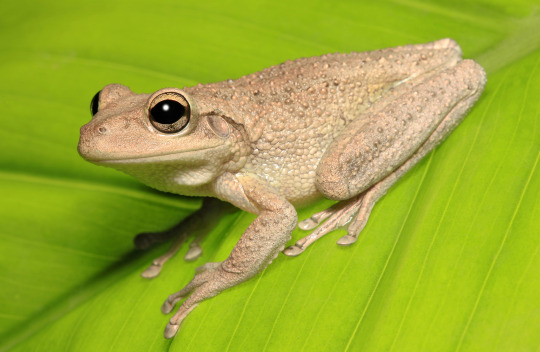
Cuban Tree Frog (Osteopilus septentrionalis)
This heart-melter is native to Cuba, the Cayman Islands and the Bahamas, but an invasive species in places like Florida. These little invasive troublemakers enjoy clogging toilet drains and climbing into power boxes to cause power outages! But look at that face…how can you not forgive them…
photo credit
#frog#frogs#mine#frogcore#toads#toad#toadcore#cuban tree frog#invasive species#cottagecore#naturecore#frogblr#toadblr#frogposting#nature#animals#amphibians
121 notes
·
View notes
Text
The Cuban Treefrog + A Gross Story About One of Florida's Most Annoying Invasive Species
The Cuban Treefrog + A Gross Story About One of Florida’s Most Annoying Invasive Species
The Cuban treefrog is my #1 hated invasive species for a number of reasons ranging from ecological damage to personally anger-inducing events and even slightly barf-worthy situations. I’ll explain that last one in a moment.
Cuban treefrogs are an invasive species from the Caribbean Islands that arrived in the US mainland most likely as stowaways aboard boats and as hitchhikers inside of cases of…
View On WordPress
#Cuban tree frog#Cuban treefrog#experience#invasive species#Osteopilus septentrionalis#personal experience#story#tree frog#treefrog
0 notes
Photo

Cuban Treefrog (Osteopilus septentrionalis) #herping #florida #cuba #nature #wildlife #invasive #fieldherping #wildlifephotography #herpetology #herpsofig #research #wild #nature #biology #canon #frog #citsci #herpmapper #insituherps (at Gainesville, Florida) https://www.instagram.com/p/Bngi_HfgYgs/?utm_source=ig_tumblr_share&igshid=o6h0zgubetw9
#herping#florida#cuba#nature#wildlife#invasive#fieldherping#wildlifephotography#herpetology#herpsofig#research#wild#biology#canon#frog#citsci#herpmapper#insituherps
3 notes
·
View notes
Photo

A naturalist holds an enormous Cuban Tree Frog (Osteopilus septentrionalis) found in Southern Florida, obviously an invasive species there.
photograph by Dick Bartlett
63 notes
·
View notes
Quote
Favorite tweets: Spotted on my porch: one large Cuban tree frog, osteopilus septentrionalis? Something spelled similarly to that. pic.twitter.com/jSIrlp9Err— Renaissance Mandalorian (@indik) March 19, 2020
http://twitter.com/indik
0 notes

